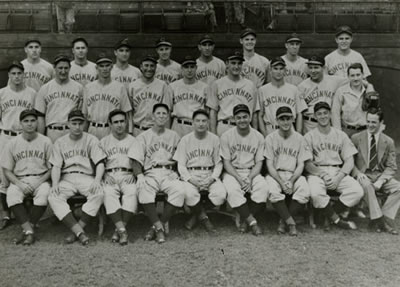Professional baseball originated in Cincinnati, Ohio. The first game played by a team where all players were professionals and received pay for playing occurred on June 1, 1869, when the Cincinnati Red Stockings defeated the Mansfield Independents, an amateur club. The Red Stockings won by a score of forty-eight to fourteen. The salary for the entire Cincinnati team during the 1869 season was eleven thousand dollars. The Red Stockings went on to win 130 consecutive games during 1869 and early 1870, not losing a game until June 14, 1870. Baseball historians challenge the number of games, because a majority of them involved amateur clubs losing to the Red Stockings. Nevertheless, the club had fifty-seven straight victories against other highly-ranked and professional or semi-professional teams.
The Reds proved to be a leading contender during its first several decades of existence. In 1876, the team was one of the original members of the National League, but this organization expelled the club in 1880 for selling beer at the team's games. The Reds returned to the National League after a decade's absence.
In 1919, the Cincinnati Reds won its first World Series, defeating the Chicago White Sox five games to three in a best of nine series. Several White Sox players eventually admitted to throwing the series to the Reds, but Reds outfielder Edd Roush claimed, "One thing that's always overlooked in this whole mess is that we could have beaten them no matter the circumstances. The 1919 Cincinnati Reds were better!" During the 1920s, 1930s and 1940s, the Reds continued to be playoff contenders. The club won the National League pennant in 1939 and 1940, and it won the World Series in 1940.
The Reds team played its games at League Park. Over the years, the field underwent numerous changes in both the stadium's name and amenities. In 1912, the field became known as Redland Field, and then, in 1934, Powel Crosley, the team's new owner, renamed it Crosley Field. The club remained at this field until 1970. On May 24, 1935, Crosley Field hosted the first night game in Major League Baseball's history. The team held seven night games during the 1935 season. Attendance soared, with an average attendance of eighteen thousand fans at the night games, and fewer than five thousand at the day games. The Cincinnati Reds and its players also participated in numerous other firsts, including the only pitcher, Johnny Vander Meer, to pitch back-to-back no-hitters in 1938, and the first televised baseball game in 1939. The team's fans also participated in a less honorable event -- stuffing the ballot box for the 1957 All-Star Team. Reds players won eight of the nine starting positions on the National League team. The National League's head office removed three of the players from the starting line-up.
The 1970s brought a new era of baseball greatness to Cincinnati. In 1970, Pete Rose signed the first six-figure contract in club history. That same year, the Reds moved to a new ballpark, Riverfront Stadium, which they shared with the city's professional football team, the Cincinnati Bengals. With the addition of players like Joe Morgan and Johnny Bench, the Reds won the National League pennant in 1972. Nicknamed the Big Red Machine, the Cincinnati Reds seemed unstoppable for the rest of the 1970s. The club won back-to-back World Series in 1975 and 1976 under manager Sparky Anderson. The Reds' good fortune continued in the 1980s and early 1990s, with the club winning the World Series in 1990. A black mark for the team, however, was Major League Baseball imposing a lifetime ban from baseball for Pete Rose for gambling. Marge Schott, the owner of the Reds beginning in 1984, also made several racist comments, bringing negative attention to the team. Despite the acquisition of renowned players like Ken Griffey, Jr., during the mid to late 1990s and the early 2000s, the team struggled to attain its former greatness.
